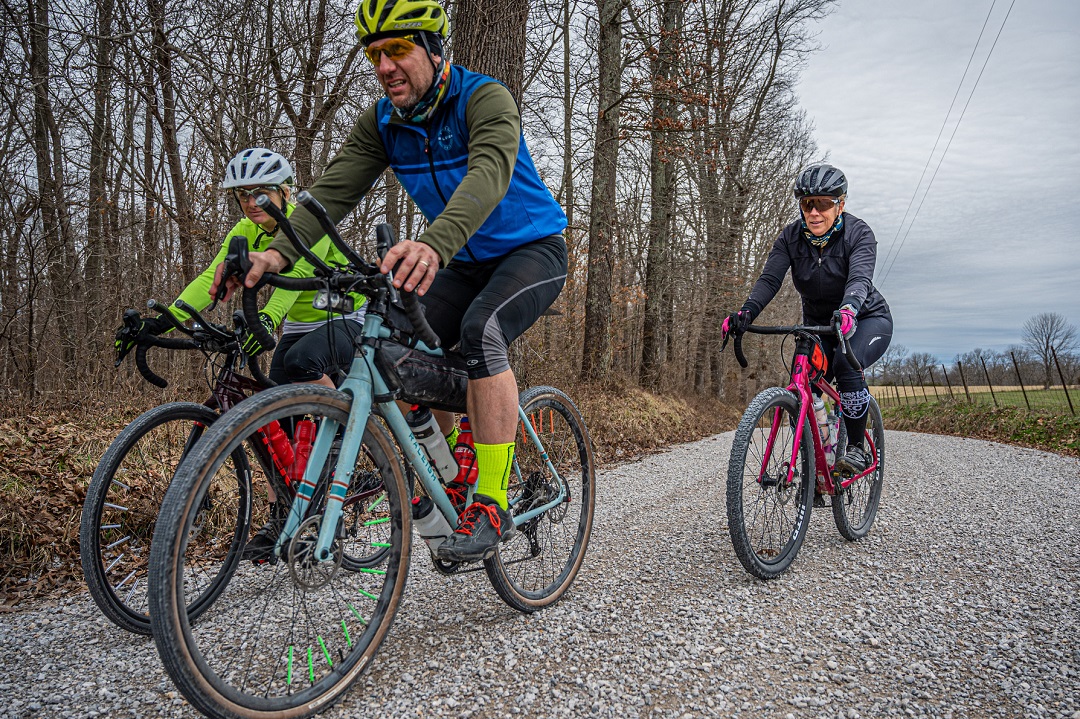Like many cyclists, I started gravel grinding to maintain my fitness during the winter months, when trail conditions weren’t ideal for mountain biking and it was too cold to ride road. But the more I rode gravel, the more I came to appreciate how these rides held much more significance than a simple workout. For me, these rides have deepened my connection with fellow gravel cyclists and with the world around me.
The past few years have seen significant growth in the popularity of gravel cycling, particularly in the Midwest, with our miles and miles of gravel roads ripe for exploring. And because people wanted to escape the pandemic-related confines of their homes this past year, the sport has grown even more.
Group Rides
Gravel is very conducive to riding in (socially distanced) groups because there is little traffic compared to paved roads. While maintaining road awareness, you can often ride two abreast safely and comfortably, so conversations flow freely and camaraderie builds. This connection with others — something many of us need desperately right now — keeps people coming back and riding consistently.
Cyclewerx in Cape Girardeau has promoted a Tuesday Night Group Gravel ride for the past several years, attracting anywhere from a few to more than 60 riders, kids to grandparents, at all levels of skill and experience. The bike shop also promotes special event group rides, including its New Year’s Day ride, which has become a tradition for many folks.
Gravel enthusiasts Matt and Tiffiney Smith of Jackson, Missouri, regularly plan no-drop gravel rides that coincide with the full moon, drawing people from over an hour away to join the fun. Each ride is a new route, with lots of hills and expansive views made more impressive when lit by the moon.
Group rides like these are a fantastic opportunity to meet new people, deepen friendships, and explore the region. Talk to your local bike shop and follow gravel cycling groups on social media to find outings in your area.
Communities Past and Present
I’ve lived in the Cape Girardeau area for more than 30 years, but in the past few years, I’ve discovered more about the communities, the landscape, and the history of the region simply by slowing down and enjoying where the gravel leads.
While out on rides, we’ve read plaques about the founders of communities, we’ve walked through graveyards and noticed the placement of certain headstones, we’ve stopped at country churches and chatted with parishioners, we’ve observed unique land formations that seemed significant and then researched them to learn more. These experiences have led to a reverence for those who came before us and a deeper appreciation for the land and communities we’re privileged to explore.

The Midwest offers miles and miles of gravel to explore by bike. (Marcus Janzow)
As we encounter small communities along our routes, we try to support the local businesses. We might take a mid-ride stop at a small-town coffee shop, a refueling break at the country store, or a post-ride gathering around a fire in the courtyard of a micro-brewery. We often plan our routes to incorporate these stops, and as our gravel routes expand, we continue to find new places to support.
Connecting with Nature
Gravel cycling provides a unique opportunity to connect with the natural world. By slowing down, you begin to notice more of the world around you: gravel that changes color when you cross county lines; the scent of honeysuckle, fresh-cut wood, cow manure; the views that don’t stop — whether it’s from the top of Larue Pine Hills looking out over the Mississippi River bottoms or Tower Rock under a full moon; the feel of the air on your skin as day shifts into night; the sounds of coyotes calling, cattle lowing, and frogs singing; the spiderwebs caught on your handlebars catching the light as they float around you.
These opportunities to interact with nature are grounding and offer positive impacts for our physical, mental, and emotional well-being. Gravel cycling captures the joy of choosing the road less traveled and, as poet Robert Frost says, that has made all the difference.
A Day at the Races
As the sport of gravel cycling has grown, so has the number of gravel cycling races. Whether you’re shooting for a podium spot or just want to finish, it’s empowering to challenge yourself and discover what you can accomplish. Plus, the race atmosphere will make anyone feel like a pro.
Training tips for mid-pack to back-of-the-pack racers:
- Ride in a variety of weather and road conditions
- Find some hills and climb
- Don’t be afraid of 20-mph headwinds
- Find more hills and climb
- Use the same nutrition you plan to use on race day
- Appreciate the scenic views
- Climb even more hills
Training tips from folks who land on podiums regularly:
- Train intervals — slow, fast, and long
- Incorporate cross training
- Simulate training as precisely as possible to the event, including nutrition, weather, layering, drafting, and practice starts
- Embrace the suck of hill training
- Normalize difficult to develop mental fortitude
Races to consider (most offer shorter and longer distance options):
- March: Dirty South Roubaix in Alto Pass, Ill.
- March: The Mid South in Stillwater, Okla.
- April: Open Range Gravel Race in Pratt, Kan.
- June: Unbound Gravel in Emporia, Kan.
- July: Epic 150 in Warsaw, Mo.
- August: Ozark Grav-El-Duro in Potosi, Mo.
- October: Spotted Horse Gravel Ultra in St. Charles, Iowa
- October: Big Sugar NWA Gravel in Bentonville, Ark.
- November: Oreo Roubaix Gravel Ride in Chesterfield, Mo.
Author: Missy Nieveen Phegley is a contributor toTerrain Magazine.
Top Image: Courtesy of Marcus Janzow.


Leave A Comment